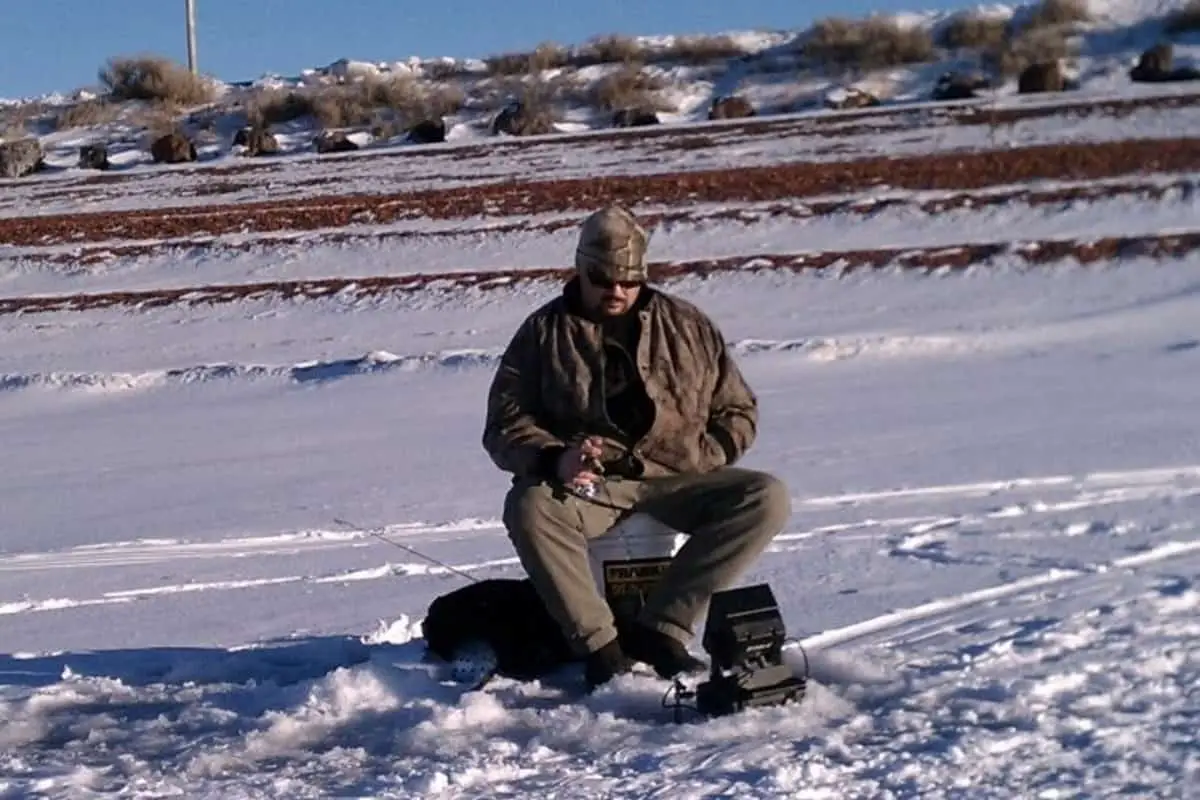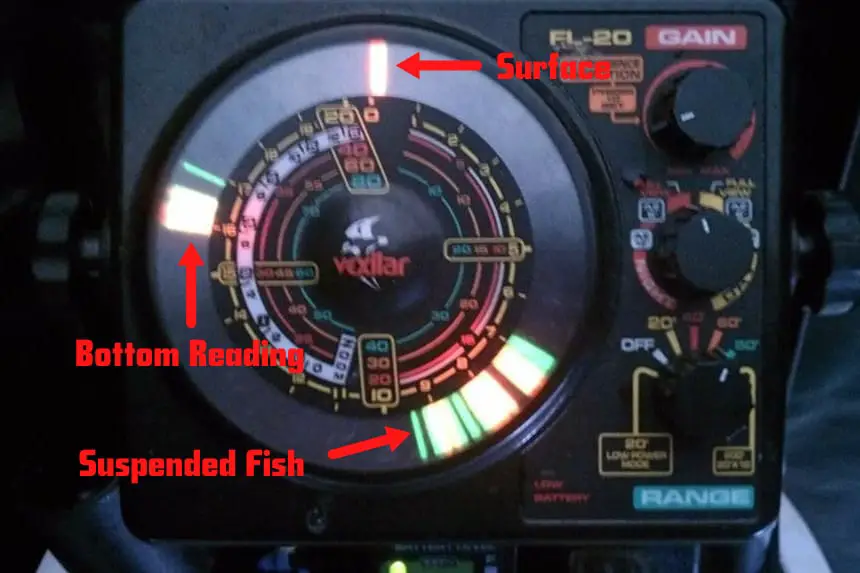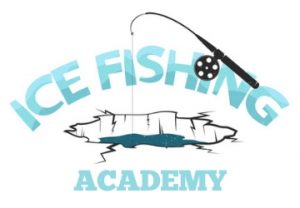Ice fishing is an entirely different ball game in comparison to summertime fishing. The water conditions are different, and the behavior of the fish is different, and your fishing strategy should change accordingly.
Where are the fish under the ice, and how far off the bottom should you fish?
You can fish the entire water column when ice fishing. The depth you fish will depend on the species being targeted. For Walleye, pike, crappies, and perch, you should rig between 10 and 30-feet. Lake trout and catfish typically operate at a depth of 18-inches to 2-feet off the bottom.
If you are not an experienced ice angler, you may not be aware of the differences when fishing in these conditions. Some fish may be found in similar locations, but others will require tweaking to your fishing technique to succeed under the ice.

How Deep Should You Ice Fish?
Many newcomers to ice fishing head out onto the ice and try to use the same fishing strategies to fish in the summertime.
In the summer heat, many fish species head for deeper water, where the temperatures are cooler, and there is less threat of predators from above.
The cooler winter temperatures change the environment significantly under the water’s surface. The water is very cold at the bottom, and slightly warmer higher up, attracting some fish usually found deeper into shallower waters.
Food is also not as abundant in the winter, which will make your bait attractive to fish on the prowl for food.
This means that using your summer fishing tactics and going deep with your bait may not get you the results you are looking for.
You will be able to find fish at all depths in the water when ice fishing, from the bottom dwellers to the mid-water depth to shallow depths. What may change is the species that you will find at these depths.
One of the most common mistakes that new ice fishing anglers make is to try and fish too deep. This often puts their bait below the level of the fish and results in very few bites.
Take Into Account The Underwater Landscape
Take the underwater landscape into account when setting your depth if there is a layer of grassy vegetation on the bottom, set your bait height to be slightly above the vegetation.
Fishing your baits or lures in this manner will make your lure more visible to predators hiding in the vegetation trying to ambush a meal.
Drop-offs, bays with still water, channels, and sandbars will yield different results and require fishing at different depths.
A topographical map of the fishing waters will help you find the right location for the species you are targeting, especially if unfamiliar with the fishing location.
Pro Tip: The free cell phone Boating App from Navionics (available for Android and iPhone) found on Google Playstore will give you a considerable edge in finding excellent fishing spots!
At What Depth Can You Find Different Fish Species When Ice Fishing?
To give you an idea of the depths you should be ice fishing for different fish species, here are the general depths at which you will find species often targeted by ice fishermen.
- 10 to 20-feet below the ice. This is the domain of your typical top feeders that will feed on items that have fallen into the water or small fish that live in the shallows. These will be fish such as muskies, trout, pike, pickerel, and salmon. Shiners, insects, and worms are all good baits at this depth since these fish prefer eye-catching prey that move actively.
- Mid-range 15 to 30-feet below the ice. The mid-range depth of the water column will be inhabited by fish species of various sizes, from the smaller perch, bluegills, and younger bass to the older, larger bass at the lower of the mid-range depths. These fish prefer fast-moving, larger baits, and lures. Brightly colored or shiny lures will do well at this depth. Worms, maggots, grubs, cut baits, and jigs also do well at this depth and will catch a range of fish species depending on the size of the bait.
- Deepwater 25 to 40-feet below the ice. This is really deep water and is typically the domain of the bottom-feeding catfish or the lake trout, which spend the winter at deeper levels. These fish can even be found close to the bottom in lakes that are much deeper than 40-feet. These fish will take anything that looks like food, making cut bait, fishheads, chunks of raw meat, and even live bait will attract these voracious eaters. Suspending these baits 18-inches to 2-feet above the bottom will produce good results.
The depths indicated will depend on the lake’s total depth, which means the depth below the ice and not the distance from the bottom.
Locating the Correct Depth for Larger Yellow Perch in a School of Perch
The larger perch in a school tend to swim close to a larger school of perch, but not necessarily right among them.
Schools of perch tend to be roaming flats, points, and basins at certain times of the ice season. I have found over the years that the larger perch tends to roam ABOVE the main school of perch holding beneath you.
Most ice fishermen will jig baits near the bottom, knowing perch tend to swim at those depths. But the larger perch are generally above those schools. So raise your baits two to four feet above the perch to entice the bigger fish to bite.
Ice Fish for Crappie at Different Depths Throughout the Day
When you’re targeting crappie, which is a great-tasting fillet, you’ll find them at different depths throughout the course of the day. Once you understand this, you’ll consistently put crappie on the ice!
Mornings and evenings, you will find them shallow as they come in to feed and chase minnows and small crustaceans. As a rule, they’re not too tricky to catch, and they will actively feed and be found near docks and shallow structures.
During the midday, though, you almost certainly need a fish finder or flasher to locate them. Crappie during the day will most likely be “suspended” somewhere in the water column over deeper basin water.
I’ve found them suspended in the water column holding between 20′ and 30′ deep, holding over 45′ of water. Where crappie suspend and hold will have a lot to do with the time of day, amount of sunlight penetrating the ice, and water temps.

Most ice fishermen will not venture out to those depths of water to fish, and if they did, they generally fish close to the bottom – beneath the crappie schools!
Change Up Your Ice Fishing Depths
Ice fishing is all about enjoying fishing in the winter, and just like summer fishing, if one tactic is not working for you, try to change things up a little and try something new or different.
Approach the ice fishing with an open mind and be willing to try fishing at different depths and with different baits, lures, or rigs.
Another approach is to change locations on the ice. If one ice fishing hole is proving to be unproductive, examine the surrounding territory to find a location that may be more productive.
If you have been fishing deep, try a spot that is not as deep; try a location near an underwater object such as a submerged tree or a shallow bed with a drop-off.
One of the best strategies to find a good fishing spot is to see what the local fishermen do. Where are they fishing, and what depth are they fishing at?
Local knowledge and insight are great assets to improving your ice fishing success!
Part of the fun of learning to ice fish is the challenge of getting it right and learning new techniques.
So don’t be averse to trying fishing techniques that you have never tried before, different baits and lures, or even different lines.
It is all part of the ice fishing learning experience, the challenge, and the adventure!
Conclusion
Ice fishing is a means to extend your fishing obsession into the winter season and enjoy your hobby all year through.
The new challenges that ice fishing brings will add a new dimension to the sport as enjoyable as any summer fishing experience. There is no feeling quite like pulling your first fish out of that hole in the ice and enjoying it that night for dinner!
Getting the depth right for certain fish species is one of the challenges that you will face with ice fishing, but you will also find that you can fish the entire water column quite successfully by tweaking your bait and lures at different depths!
Have fun and stay safe out there!
